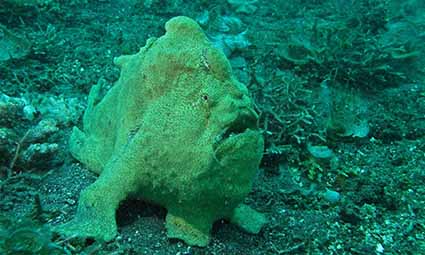 Giant Frogfish: Unique Aquatic Creatures
Giant Frogfish: Unique Aquatic Creatures
The giant frogfish is one of the unique animals that live in the aquatic environment, and these creatures are characterized by being well camouflaged, and adapted to the ocean, to the point that they are rarely discovered.
Where the giant frogfish is found
The giant frogfish is from the genus (Antennarius), and belongs to the phylum Chordata, the phylum Vertebrates, from the class Ray-finned.
These fish are widely distributed, and can be found throughout the tropical Pacific Ocean, the eastern Atlantic Ocean, and the eastern Pacific Ocean, as well as in Hawaii (Kona), the Indian Ocean, Japan, the Red Sea, tropical Australia, the western Atlantic Ocean, Indonesia, and Asia.
Frogfish take on many different color forms throughout their life cycle.
The giant frogfish are aquatic animals, found in coral reefs, lagoons, protected rocky reefs, and structures such as sea jetties.
The giant frogfish prefers shallow waters that average 20 metres deep, but can be found at depths of up to 70 metres.
Giant Frogfish Morphology
Giant frogfish are members of the Antennariidae family and can grow up to 15 inches long.
Giant frogfish are poor swimmers, like all frogfish, instead using their pelvic and pectoral fins to “walk” along the sea floor, anchoring themselves in place for an ambush.
Like other members of the frogfish family, the giant frogfish has a spherical, expandable body with a large mouth, meaning that the giant frogfish’s lower jaw extends further forward than its upper jaw, allowing it to swallow prey as large as itself.
It can change its colour to match its background, which is why it appears quite camouflaged. However, the coloration of the giant frogfish is often dominated by gray or black, or related colors such as red, orange, pink, and brown.
The giant frogfish also has skin that allows it to blend in better with its background as well.
The warty, scab-like discoloration helps the fish look more like the coral and rocks it hides in.
The dark spots on the skin are designed to look like holes in the coral.
Giant frogfish diet
Giant frogfish are carnivorous predators, but because giant frogfish (as well as all frogfish) are poor swimmers, they need to find a different hunting strategy to find and feed.
Giant frogfish use their near-perfect camouflage to hide, and they use their powerful pelvic and pectoral fins to hold themselves in place.
Like a true hunter, frogfish have a specialized lure called Illicium, which they use to attract prey.
Frogfish are known to be clumsy and voracious predators, and will happily eat anything as large as themselves, even other frogfish.
Large frogfish are known to be attracted to divers, as they disturb the fish, making it the perfect opportunity for a meal.
Some giant frogfish have been seen eating up to seven fish in ten minutes.
Large frogfish reproduction stages
Large frogfish are solitary creatures, spending their time hidden among the corals and sponges of their reef habitat, patiently waiting for prey.
The only time large frogfish come together is to breed, and if the male stays around long after the female has eaten him.
A few days to several hours before she is ready to mate, the female large frogfish will begin producing eggs.
Their stomachs swell noticeably as the eggs absorb water, and a single female can produce between 40,000 and 180,000 eggs.
About two days before laying eggs, the male frogfish begins to approach the female.
Source: teketrek.net


















